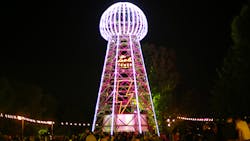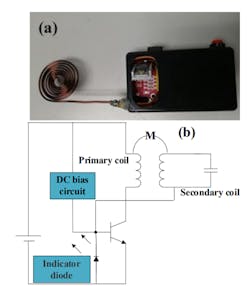The Story of Tesla’s Tower, His Coil, and EMI
This article is part of the TechXchange: Delving into EMI, EMC and Noise
Members can download this article in PDF format.
What you'll learn:
- The role of J.P. Morgan in getting Tesla's Tower built.
- The fundamental operation of a Tesla coil.
- Dealing with EMI generated by a Tesla coil.
When I lived in Long Island, N.Y., I had a most interesting experience when visiting Nikola Tesla’s Wardenclyffe Tower location. The tower stood tall from 1901 to 1917, on a 200-acre plot, in this remote location on the North Shore of Long Island. It wasn’t far from my home for most of my life.
Now just imagine a relatively small Tesla coil able to generate an electromagnetic field that could induce electrical currents in nearby conductors. Imagine how much havoc this could wreak on present-day computers, communications, building wiring, and other electronics. Tesla’s Tower would be far more powerful than a small, experimental coil tested in a lab.
Figure 1 shows the massive tower that was to be a new universal telecommunications system spanning the globe. This would be the downfall of Nikola Tesla scientifically and financially.
Tesla ultimately persuaded J.P. Morgan to sign a contract totaling $150,000 to build and develop this “communication” tower. Morgan had his doubts about the project, but Tesla convinced him that this would be a grander experiment than Marconi’s radio.
The tower, constructed out of wood and rising to 187 feet, featured a 68-ft. diameter metal hemisphere of a dome called a cupola. Huge electric transformers and generators had to be built for the Westinghouse Electric Company to deliver power to this project.
Tesla’s final hope was to generate electricity from the huge resources of the power plant adjoining the Niagara Falls and distribute power all over the world.
Unfortunately, in 1906, Tesla had a bout of nervous breakdowns. This was the beginning of the end for this project, and in 1911, it was abandoned. The tower was subsequently razed and sold as scrap.
Tesla Coils in the New Millennium
The modern Tesla coil power source is connected to a primary that performs much like a sponge, soaking up the electrical charge. The copper primary coil is an excellent conductor and can handle a huge charge with massive current surges.
The device functions via a capacitor building up a very large amount of charge that will ultimately break down the air resistance in the spark gap. Electric current is then forced out of the capacitor and into the primary coil, which creates a magnetic field. This process easily collapses the magnetic field via the huge amount of energy and thus generates electricity in the secondary coil.
Sparks are created by the voltage between the two coils. This will move the energy back and forth rapidly between the primary and secondary coils. That energy will quickly grow and eventually break free in the form of an impressive arcing electric charge event.
To that end, Nikola Tesla’s Spirit Radio was constructed with a simple crystal radio circuit that had complex rotating nickel detectors and sensitive relays. It was able to generate “spooky” sounds from different kinds of electromagnetic interference. In 1901, Tesla said, “My first observations positively terrified me as there was present in them something mysterious, not to say supernatural, and I was alone in my laboratory at night.”
The Ancient Code Team demonstrates how to build a replica of Tesla’s “Spirit Radio” here.
Tesla Coil EMI
Tesla coils are typically operated in a high-energy pulse mode. A powerful but brief electromagnetic field is generated and transfers a large quantity of energy in quite a short interval.1 The only exceptions are solid-state Tesla coils (SSTCs) and vacuum-tube Tesla coils (VTTCs), which have a lower peak current and higher root-mean-square (RMS) current. A powerful magnetic field is formed around the coil and has peaks right before a spark breaks out.
The powerful magnetic field, generated by an unshielded Tesla coil, is able to induce currents in all materials and equipment that can conduct a current. This form of EMI can wreak havoc on computers, electric lighting, and most electronic systems/devices, even if these devices have built-in protection. The Tesla coil has a very steep rising edge, from its pulsed discharge, and will generate a huge amount of EMI to anything in its path.
Televisions, radios, and digital-subscriber-line (DSL) broadband modems will be particularly susceptible since they have a similar spectrum in the 39-kHz to 5-MHz range.
Early Radio Transmission
The first kinds of radio transmitters had some form of Tesla-type coils. The modulation to the antenna, creating radio signals, came from a spark gap that created a huge amount of RF noise (EMI). The signal that was transmitted had very large energy peaks from those spark gaps.
Early on, laws were passed that banned the use of spark-gap transmitters. Also, to thwart “pirate” radios, it was made illegal to modulate a transmitted signal via spark gap.
To help minimize the above issues, designers began to improve grounding and many times enclosed the Tesla coil in a Faraday cage.
Modern Times with EMI from a Tesla Coil
Fast forward to 2022, we find that an intelligent electronic lock, which integrates electronic, computer, and mechanical assembly technology, is able to unlock via fingerprint identification, radio-frequency (RF) card, and face recognition. Smart homes are deploying such devices.
The electronic lock is quite vulnerable to interference from a Tesla jammer probe’s EMI field. At thousands of volts/m, it can disrupt the safety of an electronic lock.
After being attacked with EMI, the intelligent electronic lock may cause buzzer whistling, unlocking motor or relay action error, key touchscreen failure, and even restart and system crash. Thieves will now be able to access the property.
It was discovered that the electromagnetic coupling mechanism of the lock is mainly related to:
- Interference angle and position
- Interference field strength
- Interference frequency
Research results provide a good reference for IC researchers and application engineers to create improved reliability of ICs, as well as the electromagnetic compatibility (EMC) of electronic products. Researchers subsequently created a Tesla jammer2 made of conducting wire, battery, switch, resistor, capacitor and two-stage coil (Fig. 2).
In the end, this research will enable intelligent electronic lock designers to improve EMI protection of the internal IC from Tesla coil jammers.
Summary
Nikola Tesla was a brilliant, but troubled, genius. His creation of the Tesla coil was a moment of brilliance, leading to a device that’s used even today in many designs, mostly in a modified, improved architecture.
Tesla coils, however, create massive EMI disturbances in neighboring electronics. Designers must use these devices cautiously so that they will perform as desired in an electronic design and not intrude on any electronic devices within range.
Read more articles in the TechXchange: Delving into EMI, EMC and Noise
References
1. Grounding, circuit protection and EMI.
2. Research on Electromagnetic Interference of Integrated Circuit for Intelligent Electronic Lock, 2020 The 5th International Conference on Integrated Circuits and Microsystems.


